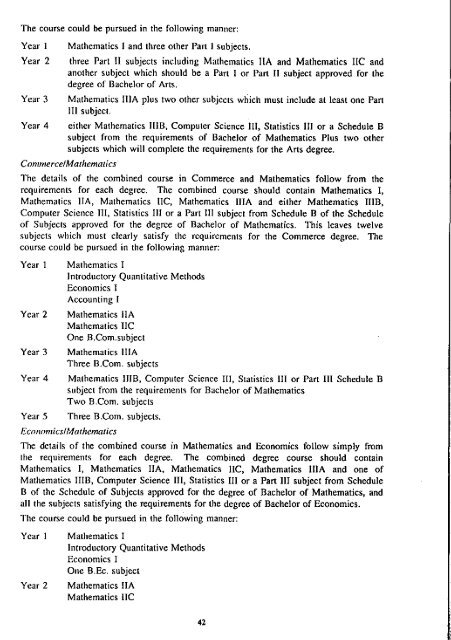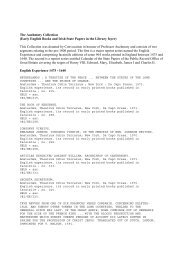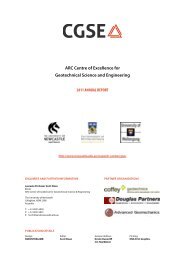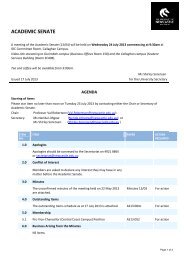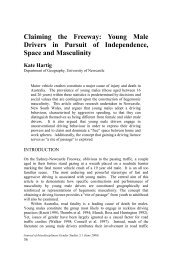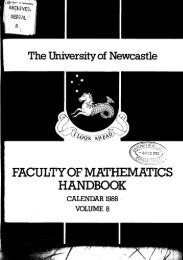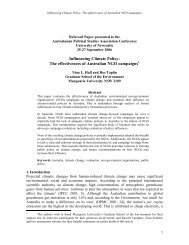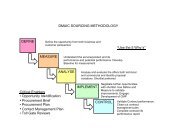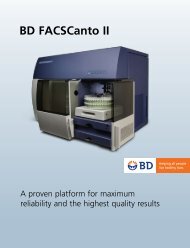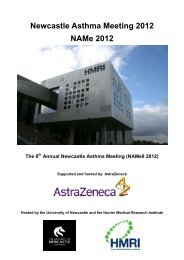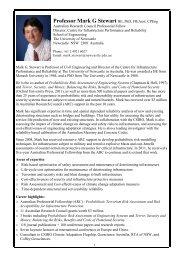Faculty of Mathematic Handbook,1987 - University of Newcastle
Faculty of Mathematic Handbook,1987 - University of Newcastle
Faculty of Mathematic Handbook,1987 - University of Newcastle
Create successful ePaper yourself
Turn your PDF publications into a flip-book with our unique Google optimized e-Paper software.
The course could be pursued in the following manner:<br />
Year I<br />
Year 2<br />
Year 3<br />
Year 4<br />
<strong>Mathematic</strong>s I and three other Part I subjects.<br />
three Part II subjects including <strong>Mathematic</strong>s IIA and <strong>Mathematic</strong>s lIe and<br />
another subject which should be a Part I or Part II subject approved for the<br />
degree <strong>of</strong> Bachelor <strong>of</strong> Arts.<br />
<strong>Mathematic</strong>s iliA plus two other subjects which must include at least one Part<br />
III subject.<br />
either <strong>Mathematic</strong>s IIlB. Computer Science III, Statistics III or a Schedule B<br />
subject from the requirements <strong>of</strong> Bachelor <strong>of</strong> <strong>Mathematic</strong>s Plus two other<br />
subjects which will complete the requirements for the Arts degree.<br />
Commerce/<strong>Mathematic</strong>s<br />
The details <strong>of</strong> the combined course in Commerce and <strong>Mathematic</strong>s follow from the<br />
requirements for each degree. The combined course should contain <strong>Mathematic</strong>s I,<br />
<strong>Mathematic</strong>s IIA, <strong>Mathematic</strong>s IIC, <strong>Mathematic</strong>s IlIA and either <strong>Mathematic</strong>s IIIB,<br />
Computer Science III, Statistics III or a Part III subject from Schedule B <strong>of</strong> the Schedule<br />
<strong>of</strong> SubJects approved for the degree <strong>of</strong> Bachelor <strong>of</strong> <strong>Mathematic</strong>s. This leaves twelve<br />
subjects which must clearly satisfy the requirements for the Commerce degree. The<br />
course could be pursued in the following manner:<br />
Year I<br />
Year 2<br />
Year 3<br />
Year 4<br />
Year 5<br />
<strong>Mathematic</strong>s I<br />
Introductory Quantitative Methods<br />
Economics I<br />
Accounting I<br />
<strong>Mathematic</strong>s IIA<br />
<strong>Mathematic</strong>s IIC<br />
One B.Com.subject<br />
<strong>Mathematic</strong>s lilA<br />
Three B.Com. subjects<br />
<strong>Mathematic</strong>s IIIB, Computer Science ITI, Statistics III or Part III Schedule B<br />
subject from the requirements for Bachelor <strong>of</strong> <strong>Mathematic</strong>s<br />
Two B.Com. subjects<br />
Three B.Com. subjects.<br />
Economics/<strong>Mathematic</strong>s<br />
The details <strong>of</strong> the combined course in <strong>Mathematic</strong>s and Economics follow simply from<br />
the requirements for each degree. The combined degree course should contain<br />
<strong>Mathematic</strong>s I, <strong>Mathematic</strong>s IIA, <strong>Mathematic</strong>s lIC, <strong>Mathematic</strong>s lIlA and one <strong>of</strong><br />
<strong>Mathematic</strong>s IIlB, Computer Science III, Statistics III or a Part III subject from Schedule<br />
B <strong>of</strong> the Schedule <strong>of</strong> Subjects approved for the degree <strong>of</strong> Bachelor <strong>of</strong> <strong>Mathematic</strong>s, and<br />
all the subjects satisfying the requirements for the degree <strong>of</strong> Bachelor <strong>of</strong> Economics.<br />
The course could be pursued in the following manner:<br />
Ycar I<br />
Year 2<br />
<strong>Mathematic</strong>s I<br />
Introductory Quantitative Methods<br />
Economics I<br />
One B.Ec. subject<br />
<strong>Mathematic</strong>s IIA<br />
<strong>Mathematic</strong>s lIC<br />
42<br />
Year 3<br />
Year 4<br />
Year 5<br />
One B.Ec. subject<br />
<strong>Mathematic</strong>s lIlA<br />
Eonomics II<br />
Two B.Ec. subjects<br />
<strong>Mathematic</strong>s lIIB, Computer Science III, Statistics III or a Part III Schedule B<br />
subject from the requirements for B.Math.<br />
Two B.Ec. subjects.<br />
Three B.Ec. subjects<br />
Engineering/<strong>Mathematic</strong>s<br />
B.E.lB.Math. in Chemical Engineering<br />
B.E.lB.Math. in Civil Engineering<br />
B.E./S.Math. in Computer Engineering<br />
B.E.lB.Math. in Electrical Engineering<br />
B.E.lB.Math. in Industrial Engineering<br />
B.E.lB.Math. in Mechanical Engineering<br />
The details <strong>of</strong> the combined course in <strong>Mathematic</strong>s and Engineering follow simply from<br />
the requirements for each degree. The combined degree course should contain<br />
<strong>Mathematic</strong>s I, <strong>Mathematic</strong>s IIA, <strong>Mathematic</strong>s IIC, <strong>Mathematic</strong>s IlIA and one <strong>of</strong><br />
<strong>Mathematic</strong>s IIIB, Computer Science III, Statistics III or a Part III subject from Schedule<br />
B <strong>of</strong> the Schedule <strong>of</strong> Subjects approved for the degree <strong>of</strong> Bachelor <strong>of</strong> <strong>Mathematic</strong>s, and<br />
all subjects satisfying the requirements for the degree <strong>of</strong> Bachelor <strong>of</strong> Engineering.<br />
Candidates wishing to enrol in a combined degree should liaise with the relevant Head <strong>of</strong><br />
Department and the Dean <strong>of</strong> the <strong>Faculty</strong> <strong>of</strong> <strong>Mathematic</strong>s concerning approved subJects.<br />
See the <strong>1987</strong> <strong>Faculty</strong> <strong>of</strong> Engineering <strong>Handbook</strong> for subjecUunit descriptions.<br />
<strong>Mathematic</strong>s/Science<br />
The details for the combined course follow simply from the requirements for each degree.<br />
Each degree requires nine subjects so the combined degree requires 18 subjects less four<br />
subjects for which standing may be given, thus the combined degree should contain 14<br />
subjects. The Bachelor <strong>of</strong> <strong>Mathematic</strong>s requires <strong>Mathematic</strong>s I, <strong>Mathematic</strong>s IIA,<br />
<strong>Mathematic</strong>s IIC, <strong>Mathematic</strong>s IlIA and one <strong>of</strong> <strong>Mathematic</strong>s IlIB, Computer Science III,<br />
Statistics TIl or a Part III subject from Schedule B <strong>of</strong> the requirements. This leaves nine<br />
subjects which must clearly satisfy the requirements for the Science degree.<br />
The course could be pursued in the following manner:<br />
Year 1<br />
Year 2<br />
Year 3<br />
Year 4<br />
<strong>Mathematic</strong>s I and three other Part I subjects.<br />
three Part II subjects including <strong>Mathematic</strong>s IIA and <strong>Mathematic</strong>s IIC and<br />
another Part I subject.<br />
<strong>Mathematic</strong>s lIlA plus two other subjects which must include at least one Part<br />
III subject.<br />
one <strong>of</strong> <strong>Mathematic</strong>s IIIB, Computer Science III, Statistics III or a Schedule B<br />
subject from the requirements for Bachelor <strong>of</strong> <strong>Mathematic</strong>s, plus two other<br />
subjects which will complete the requirements for the Science degree.<br />
43


